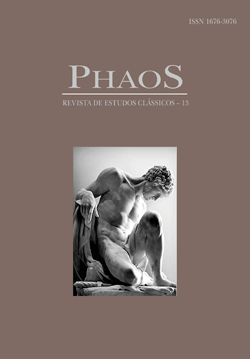Communicative Language Teaching in ancient Greek primary classes
Palabras clave:
Teaching ancient Greek. Methodology of Greek. Communicative language teaching.Resumen
Following this motion towards multilingualism, the National Curriculum in the U.K. - as a national plan to promote multilingualism - requires all Key Stage 2 children of primary education to learn Latin and ancient Greek, among seven-strong shortlisted languages: French, German, Spanish, Italian, Mandarin, Latin and ancient Greek. The Department for Education reasons that both languages provide the foundation for learning Modern Foreign Languages (MFLs) and reading comprehension; as well as a good grounding in grammar, syntax and vocabulary, which can boost pupils’ understanding of other modern languages. In addition, they have enormous cross-curricular potential, drawing in literacy, history, science, geography, art, drama and philosophy. In this context, this paper discusses the teaching of ancient Greek through the Communicative Language Teaching (CLT) approach, aiming at: (i) introducing the method with examples of current classroom practices in a primary class of bilingual children; (ii) reflecting upon current research on ancient Greek and Latin learning; and (iii) proposing possible strategies and design for the improvement of ancient Greek teaching, within the broader framework of multilingualism.Citas
Allen, W.S. (1968). Vox Graeca. A guide to the pronunciation of classical Greek. Cambridge: Cambridge University Press.
American Classical League, and American Philological Association. 1997. Standards for classical language learning. Available at: http://department.monm.edu/classics/cpl/standards.pdf
American Classical League, and American Philological Association. 2010. Standards for Latin teacher preparation. Available at: https://www.aclclassics.org/uploads/assets/files/Standards_for_Latin_Teacher_Preparation.pdf
Anderson, P., and Beckwith, M. (2010). Form-focused teaching for the intermediate Latin student. Teaching Classical Languages, 2(1): 31-52.
Antonopoulou, Ε. (2007). Η προφορά της αρχαίας Ελληνικής (The pronunciation of ancient Greek). Available at:
http://www.greek-language.gr/greekLang/studies/history/thema_08/index.html
Bayerle, H. (2013). Team-based learning to promote the study of Greek. Teaching Classical Languages, 5 (1): 15-29.
Caragounis, C.C. (1995). The error of Erasmus and un-Greek pronunciations of Greek. Filología Neotestamentaria, 8: 151-185.
Carlon, J. M. (2013). The Implications of SLA research for Latin pedagogy: modernizing Latin instruction and securing its place in curricula. Teaching Classical Languages, 4 (2): 106-122.
Coffee, N. (2012). Active Latin: quo tendimus? Classical World, 105 (2): 255-269.
Department for Education. 2013. Consultation report: foreign languages at Key Stage 2. Available at: https://www.education.gov.uk/consultations/downloadableDocs/ks2_choice_of_languages_consultation_report_final_published%20(2).pdf
Dugdale, E. (2011). Lingua Latina, lingua mea: creative composition in beginning latin. Teaching Classical Languages, 3 (1): 1-23.
Ellis, N.C., Natsume, M., Stavropoulou, K., Hoxhallari, L., Van Daal, V., Polyzoe, N., Tsipa, M., and Petalas, M. (2004). The effects of orthographic depth on learning to read alphabetic, syllabic and logographic scripts. Reading Research Quarterly, 39 (4): 438-468.
Fort, M. (2006). Educational reforms across Europe: a toolbox for empirical research. Available at: http://www2.dse.unibo.it/fort/files/papers/fort_reforms.pdf
Garrouste, C. (2010). 100 Years of educational reforms in Europe: a contextual database. Italy: European Union. Available at:
http://publications.jrc.ec.europa.eu/repository/bitstream/111111111/14920/1/reqno_jrc57357.pdf
Gephardt, L. (2011). Classics in American schools. Expositions 5 (2): 9-13.
Gay, B. (2003). Classics teaching and the national curriculum. In J. Morwood (Ed.), The teaching of Classics, pp. 20-35. Cambridge: Cambridge University Press.
Gruber-Miller, J. (2013). Engaging multiple literacies through remix practices: Vergil recomposed, Teaching Classical Languages 4 (2): 141-161.
Holliday, A. (1994). Appropriate methodology and social context. Cambridge:
Cambridge University Press.
Horrocks, G. Greek. (2010). A history of the language and its speakers. Chichester/Malden, MA: Wiley-Blackwell.
Howatt, A. P. R. (1984). A history of English language teaching. Oxford: Oxford University Press.
Knight, P. (2001). The development of EFL methodology. In C. N. Candlin and N. Mercer (Eds.) English language teaching in its Social context, pp.160-173. London / New York: Routledge.
Larsen-Freeman, D. (1986). Techniques and principles in language teaching. Oxford: Oxford University Press.
Manousakis, N. (2013). Blended learning in an advanced course on Greek tragedy. Teaching Classical Languages, 5 (1): 30-49.
Mertzani, M. (2014). Literary micro-ecologies for the teaching of second languages. Current practices from Greek. Paper presented at 5° Seminário Nacional de Língua e Literatura: Teoria e Ensino – Leitura, produção discursiva e multimodalidade. Available at: http://www.upf.br/snll/images/pdf/Anais-2014/9-literary-micro-ecologies-for-the-teaching-of%20second-languages.pdf
Mitchell, R. (1994). The communicative approach to language teaching: an introduction. In A. Swarbrick (ed.) Teaching modern languages, London: The Open University.
Moss, J.S. (2013). Computer-assisted learning in second-year Latin. Teaching Classical Languages, 4 (2): 86-105.
Pennycook, A. (1994). The cultural politics of English as an international language.
London: Longman.
Petrounias, Ε.Β. (2007). Οι τύχες των αρχαίων ελληνικών λέξεων στο νεότερο κόσμο: λεξιλόγιο και διαχρονικότητα της ελληνικής γλώσσας (The fortunes of ancient Greek words in modern world: vocabulary and timelessness of Greek language). Available at:
http://www.greek-language.gr/greekLang/studies/history/thema_16/08.html
Rasinski, T., Padak, N., Newton, R.M., and Newton, E. (2008). Greek and Latin roots: keys to building vocabulary. Building vocabulary from word roots. USA: Shell Education.
Richards, J.C., and Rodgers, T.S. (2001). Approaches and methods in language teaching. A description and analysis. Cambridge: Cambridge University Press.
Shannon, R. (2003). Effective teaching and good practice in classics. In J. Morwood (Ed.), The teaching of Classics, pp. 43-50. Cambridge: Cambridge University Press.
Sipitanou, A., and Mavroskoufis, D. (2008). Διδακτική αρχαίων Ελληνικών – Ιστορίας (Teaching ancient Greek and History). Report Study 10. Thessaloniki:
O.EΠ.ΕΚ. Available at: http://www.oepek.gr/pdfs/meletes/oepek_meleth_10.doc
Skoyles, J.R. (1990). The origin of classical Greek culture: the transparent chain theory of literacy/society interaction. Journal of Social and Biological Structures, 13(4): 321-353.
Solomons, G. (2007). Accessing academic language: the benefits of an explicit study of Latin and Greek roots. Akroterion - Journal for the Classics in South Africa, 52: 77-85.
Descargas
Publicado
Número
Sección
Licencia
Ao se submeterem textos para a PhaoS, seus autores devem estar cientes de que, se aprovados para publicação, a revista terá sobre eles todos os direitos autorais pertinentes. Originais não serão devolvidos.

